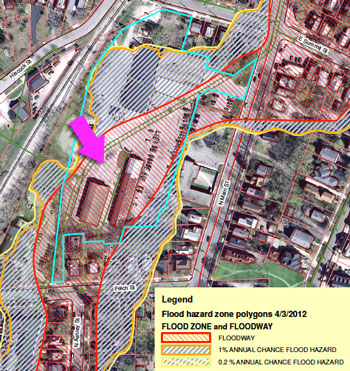Peek through window of former Delux Drapery at 624 S. Main, during demolition of Fox Tent & Awning: [photo] Fox Tent building is all rubble now. But Main Street and former Vet buildings remain: [photo]
Stories indexed with the term ‘demolition’
721 N. Main
Demolition of a former city fleet services building under way – the long, concrete-block one: [aerial view from Google Maps] MacKenzie Co. crew apparently separating recyclable metals from roof structure. [photo]
Georgetown Mall
Georgetown Mall
Heavy equipment sighted. [Demolition in anticipation of Packard Square appears imminent.] [photo]
Washington & Fifth Ave.
Mahek Indian Cuisine getting interior demo. Such a bummer; always my fave downtown buffet.
Washington & Second
Former road commission building at 415 W. Washington now bears sign reading “Renovation Yes, Demolition No!” Context is that Ann Arbor city council work session on March 25 included mention that the more likely outcome for the now vacant city-owned building is demolition. [photo] A nice shot of the whole facade from several years ago by Jim Rees: [Flickr]
FEMA Grant to Fund 721 N. Main Demolition
Two buildings on the city-owned 721 N. Main property near downtown Ann Arbor will now be demolished, using $87,704 in funds granted by the Federal Emergency Management Agency (FEMA).
The unanimous vote to accept the funds came at the council’s March 4, 2013 meeting. The 721 N. Main site is a former city maintenance yard, and is part of a … [Full Story]
Maple Village
Golden Chef building at Maple Village is history. [photo]
Former Near North Demolition Nears
An additional $96,000 has been received by the city of Ann Arbor through federal Community Development Block Grant (CDBG) allocations, which the city will put toward demolishing six houses on North Main Street.
The houses are on the site of the former Near North affordable housing project. That project, on which the nonprofit Avalon Housing had partnered, ultimately did not go forward. The city must complete the demolition by March 15, 2013.
The vote on the funding came at the council’s Feb. 19, 2013 meeting. The additional $96,000 can only be used for the demolition of structures at 700-724 North Main.
This brief was filed from the city council’s chambers on the second floor of city hall, located at 301 E. Huron. A … [Full Story]
Blake Transit Center
Yellow backhoe is starting demolition of transit center canopy in preparation for construction of new Blake Transit Center, which will front Fifth Avenue, not Fourth, like the current center. [Final approval of budget and design came Oct. 18, 2012] [photo]
Round One of Building Demolition Hearings
Ann Arbor building board of appeals meeting (Sept. 13, 2012): At its Feb. 21, 2012 meeting, the Ann Arbor city council established a $250,000 fund to pay upfront costs – if necessary – to undertake demolitions of dangerous buildings. And at its Aug. 9, 2012 meeting, the council authorized signing contracts with four different demolition companies to do the work on an as-needed basis.
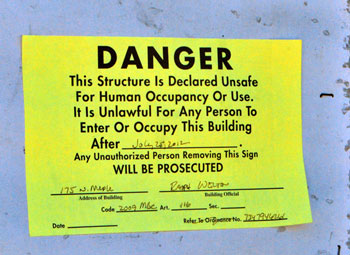
Sign posted at the old Chinese restaurant in the Maple Village Shopping Center. (Photos by the writer.)
That set the stage for the building board of appeals to hold a first set of four show-cause hearings earlier this month.
If the board finds that the property in question is a dangerous building under the city’s ordinance and Michigan’s building code, and orders the property demolished, then a property owner has 20 days to undertake the demolition or appeal the board’s ruling to the circuit court.
Because the city now has demolition companies under contract and the funds set aside to pay for upfront costs, it can back up the demolition order if a property owner fails to comply with it – by going ahead and taking the building down. Although the city would pay the initial cost, the property owner would be assessed and invoiced for the cost of the demolition, which includes an administrative fee.
So it’s more cost-effective for property owners to demolish buildings themselves, compared to having the city do the work. When the owner of one of the four condemned properties arrived late a few minutes after the Sept. 13 hearings had concluded, Ann Arbor’s chief building official Ralph Welton told him: “We’d much rather you knock it down.”
That property was a residential garage, located at 2415 Dorchester Road in the southeastern quadrant of the city. The garage has apparently become a home to chicken hawks, which roost in the open roof.
The other three properties on the board’s agenda included two houses – one at 3123 Cherry Tree Lane, off Packard near US-23, which had additional construction done on the property in a non-compliant way, resulting in conditions the city found to be dangerous. The other house on the board’s agenda was 3010 Dexter Road, on the city’s west side.
In fairly straightforward fashion, the board found all three residential properties to be dangerous buildings under the local and state code, and called for their demolition.
The one property for which a representative of the owner was on hand was 175 N. Maple, where a former Chinese restaurant is located inside the Maple Village shopping center. That hearing took the longest of the four. The back-and-forth between the owner’s representative and the board resulted in a 30-day timeframe set by the board for a plan to be submitted to rectify the conditions, and subsequent to that plan approval, a 60-day window to effect the remedy. The owner’s representative came from Brixmor Property Group, a portfolio company of the Blackstone Group real estate fund.
It was evident that the board was handling the first round of show-cause hearings for the city’s recent efforts. To craft the wording of the board’s first motion of the meeting required a group effort, including much consultation with city attorney staff and Welton. [Full Story]
Avalon Housing: Near North Won’t Work
In a letter sent to Ann Arbor councilmembers and other government officials, Avalon Housing‘s senior developer Michael Appel has announced that the Near North affordable housing project will not move forward. The development team has determined that the project, which was to include 39 new affordable housing units, 16 of them as supportive housing, is not feasible as planned. [.pdf of letter from Michael Appel]
A change to the FEMA flood maps is highlighted in Appel’s letter as a crucial factor in the inability of the project to move forward. The new maps, adopted in 2012, show an expanded floodway, which cuts across the corner of the parcel. That mean that federal funds – part of the project’s financing … [Full Story]
Ann Arbor Council: Land, Water, Buildings
Ann Arbor city council meeting (Feb. 21, 2012): Land use was one common theme that trickled through the city council’s relatively short meeting.
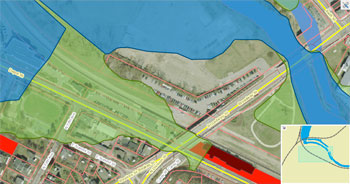
The Ann Arbor city council gave initial approval to new Federal Emergency Management Agency (FEMA) flood maps at its Feb. 21 meeting. The council briefly touched on the topic of the current location of the Amtrak train station, which is in the floodplain (green area). The dark red is a building (Gandy Dancer) that was previously not analyzed as within the floodplain, but now is analyzed as such – similarly for parcels colored bright red. (Image links to higher resolution file with legend.)
The council denied a rezoning request from the owners of Biercamp Artisan Sausage and Jerky, located on South State Street near the Produce Station, that would have allowed them to use the property for a retail operation larger than what currently exists. But the council did give initial approval to a rezoning request from the Society of Les Voyageurs that will allow the group to make an addition to their house, which is located near the Argo Dam.
At the other end of the spectrum from development, the council also took action that will allow the city to move quickly to demolish buildings that are derelict, posing a safety risk to the community. The council authorized the allocation of $250,000 from the general fund to pay upfront costs for the demolition of such structures. The city expects to be able to replenish the money out of a lawsuit settlement it won previously against the owner of the former Michigan Inn. The city will also eventually be able to recover its costs from property owners whose buildings require demolition.
Also related to possible future construction on land throughout the city, as well as the insurance for existing buildings, was the council’s initial approval of new federal flood maps. The most recent maps date from 1992. The new maps being considered for approval by the city were created out of a process begun by the Federal Emergency Management Agency (FEMA). Throughout the city, 452 structures are no longer analyzed as lying within a floodplain, while 88 buildings are newly analyzed as in a floodplain, according to the new maps.
Floods are one of the natural disasters that the city’s new emergency management director, Rick Norman, will be responsible for preparing the city to handle. The council formally authorized Norman’s appointment at their meeting.
In resolutions that required expenditures of funds, the council authorized additional outside accounting and legal expenses, as well as the painting and repair of equipment at the city’s water treatment plant.
In other business, the council passed a resolution in support of a clean air campaign, and authorized the closing of city streets for eight different upcoming events.
Two significant appointments were discussed at the meeting. The first was a mayoral nomination on which the council will be asked to take action at its next meeting – appointing Sue Gott, planner for the University of Michigan, to the board of the Ann Arbor Transportation Authority. The other was an appointment that has already been made by Gov. Rick Snyder – Joe Burke as judge to the 15th District Court. Burke was on hand to be introduced to the council. [Full Story]
Ann Arbor to Abate Unsafe Buildings
At its Feb. 21, 2012 meeting, the Ann Arbor city council approved a $250,000 allocation for the demolition of buildings that the city deems dangerous under Chapter 101 of the city code. The city would like to target buildings that are diminishing the quality of neighborhoods, dragging down property values and attracting nuisances. The appropriation is from the city’s general fund, changing the budget, and thus requires an 8-vote majority. The city expects to be able to reimburse the general fund from the proceeds of a lawsuit settlement related to the old Michigan Inn property on Jackson Avenue.
Mayor John Hiefjte described the possibility of establishing such a fund at city council’s Dec. 19, 2011 meeting. He portrayed the idea as arising out of a conversation he’d had with Stephen Kunselman (Ward 3).
This brief was filed from the city council’s chambers on the second floor of city hall, located at 301 E. Huron. A more detailed report will follow: [link] [Full Story]
Column: Digital Information Flood
At the city council’s Jan. 23, 2012 meeting, Dan Rainey – the city of Ann Arbor’s head of information technology – was on hand to receive an award recognizing the city’s use of digital technology. The award was for 5th place in the 2011 edition of the Center for Digital Government’s Digital Cities Survey.

Screenshot from the city of Ann Arbor and Washtenaw County mapping website. It shows the new floodway and floodplain boundaries for the new FEMA maps, highlighting the buildings and parcels that are no longer in the floodplain, according to the new maps. The parcel with extra highlighting (yellowish green) is one of special interest for this column.
Yet among the nearly 12,000 words in The Chronicle’s report from that meeting, there’s no mention of the city’s Digital Cities award. The decision not to include that award in the meeting report was not one about which I agonized; it was not made on the basis of some high-minded journalistic principle. From a purely practical point of view, the award was likely a victim of my finite stamina for writing about a city council meeting.
But one reason I don’t mind omitting that kind of award from a meeting report is that it really does not matter to me where Ann Arbor ranks on that survey. What matters to me is the fact that the city’s investments in the realm of digital technology make life in Ann Arbor as a local journalist easier than it would be otherwise.
And that, I think, is best illustrated with a specific example. It’s an example I stumbled across a couple of months ago. But because it overlaps with two agenda items on the city council’s next meeting, on Feb. 21, I thought now would be a good time to share it with readers. One of those agenda items involves demolishing derelict houses, and the other involves the Federal Emergency Management Agency (FEMA) flood maps.
This tale begins on Facebook and ends in the bucket of a big yellow backhoe. [Full Story]
Chapter Added to Fifth Ave. Historic Saga
Ann Arbor city council meeting (Oct. 24, 2011): Monday’s meeting was added to the council’s calendar specifically for the purpose of taking a second and final vote on the Heritage Row planned unit development (PUD). The project would have rehabbed or reconstructed a row of seven existing houses on Fifth Avenue, south of William Street, and built three new apartment buildings behind them.

In the foreground is Carsten Hohnke (Ward 5) as his council colleague Mike Anglin (Ward 5) explained the reasons why he wanted to appoint a historic district study committee for the area south of William Street along Fourth and Fifth avenues.
Heritage Row had been considered and rejected more than once before by the council, with a history in front of Ann Arbor’s legislative body dating back well over a year. The project had been brought back for reconsideration because the demolition of the seven houses was apparently imminent – as part of the construction of City Place. City Place is a different, already-approved project on the same Fifth Avenue site by the same developer.
But by the Friday before Monday’s meeting, all four agenda items related to Heritage Row (site plan, zoning ordinance and their respective public hearings) had been deleted from the agenda. The developer had withdrawn the Heritage Row project.
With the construction of City Place a virtual certainty – along with demolition of the houses – on Monday afternoon Mike Anglin (Ward 5) placed a proposal on the agenda that would have started a procedure to establish a historic district in the area. The related moratorium on demolition in the study area would have, at least temporarily, blocked the City Place development.
But in the end, the council was in no mood to repeat the same exercise it had gone through two years ago. At that time, the council had appointed a historic district study committee, then subsequently rejected the committee’s recommendation that a historic district be established in the neighborhood. Arguing against the establishment of a historic district study committee this time around, Tony Derezinski (Ward 2) said he didn’t want the council to become a joke. Later during deliberations Margie Teall (Ward 4) ventured that already, “We’ve become a bit of a joke.”
Also on Monday afternoon, two other items – which asked the council to reconsider votes it had taken at the Oct. 17 meeting about the City Place project – were placed on the agenda by Stephen Kunselman (Ward 3). Kunselman was not interested in getting the votes reversed, but had questions he wanted answered. While other councilmembers agreed to reconsider the items, the council then dispatched them with unanimous votes after Kunselman’s questions.
That left one item on the agenda – added on Friday after the agenda’s Wednesday publication – that actually resulted in a vote that might change the course of events in the city. The resolution directed city staff to make recommendations on improvements to crosswalks throughout the city. Councilmembers expressed some interest in tweaking a new pedestrian ordinance that it approved on July 19, 2010.
Also at the meeting, the council went into closed session to discuss the city attorney’s performance evaluation. It resulted in no change to city attorney Stephen Postema’s salary, but allowed him to cash out 250 hours of accrued time before Dec. 31, 2011. [Full Story]
Ann Arbor Council Delays Budget Vote
Ann Arbor city council meeting (May 16, 2011): Ann Arbor’s city charter requires that the city council amend and adopt a city budget by its second meeting in May. If it fails to act, by default the unamended budget proposed in April by the city administrator is adopted.
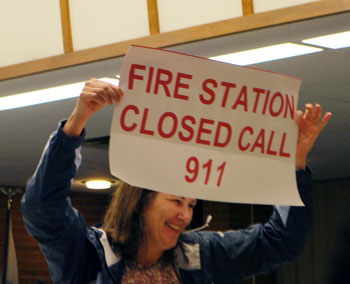
During public commentary, Sue Maguire addressed the council on the topic of proposed reductions to the fire department. (Photos by the writer.)
But Monday, at its second meeting in May this year, the city council did not act, choosing instead to recess and continue the meeting the following week, on May 23. The decision to delay was prompted by uncertainty about revenue from the public parking system. The Ann Arbor Downtown Development Authority and the city were poised to ratify a new agreement on parking revenue on May 2, but that agreement was put off when questions were raised about the DDA tax increment finance (TIF) capture. The DDA later called a special meeting on Friday, May 20 to address that issue.
Even though the council did not act on the budget, most of the evening’s discussion was dominated by budget talk, including extensive public commentary on the proposed cuts in the police and fire departments. The council also got a briefing from its chief of police and interim fire chief, Barnett Jones, who responded to an article published in AnnArbor.com about fire department response times, calling the calculations presented in the piece inaccurate.
In addition to putting off action on the FY 2012 budget, the council also tabled decisions on human services funding, funding for a water system study, and fee increases for next year.
However, the council did transact some business. It authorized an increase in taxicab fares in light of rising gas prices. The council also approved neighborhood stabilization funds for demolition of three houses on North Main Street to prepare the site for construction of the Near North affordable housing project. Two large vehicle purchases – a street sweeper and a sewer truck – that had been postponed from the previous meeting were authorized.
The council also revised its administrative policy on how the 2006 parks millage is to be spent. Funds outside the general fund can count as general fund money for the purpose of the policy, as long as those funds are not drawn from the parks millage. The council also gave initial approval to an ordinance on design guidelines for new buildings downtown. [Full Story]
Demolition for Near North Project Prepped
At its May 16, 2011 meeting, the Ann Arbor city council approved an addition to its neighborhood stabilization program (NSP) budget and a corresponding expenditure to pay for the demolition of three houses as site preparation for the Near North affordable housing project on North Main.
The addition to the NSP budget came from a reimbursement. The owner of a house paid back NSP money to the city, previously expended to demolish the owner’s property. That reimbursement amounted to $24,135. NSP funds come originally from federal grants allocated through the Michigan State Housing Development Authority (MSHDA).
In addition, city staff identified an NSP homeowner acquisition and rehabilitation project that was completed under budget by $11,750. Combined, the additional revenue to the NSP budget and the savings on the rehabilitation project amount to $35,885. Of that amount, $33,292 will be used to pay for the demolition of 718, 722, and 724 N. Main St., with the remaining $2,593 going to administration costs in the office of community development. The money will be allocated to the nonprofit Avalon Housing, which is developing the Near North project with Three Oaks.
The city council originally approved rezoning for the project – a four-story, 39-unit mixed use residential building on a 1.19-acre site – on Sept. 21, 2009
This brief was filed from the city council’s chambers on the second floor of city hall, located at 301 E. Huron. A more detailed report will follow: [link] [Full Story]
Residential Site Plan for Former Bindery OK’d
At its April 19, 2011 meeting, the Ann Arbor city council unanimously approved a site plan for 215 N. Fifth Ave. – formerly the site of the Bessenberg Bindery, which has moved to the Thomson-Shore Inc. facility in Dexter. The Fifth Avenue property is now owned by Jon and Lisa Rye. Jon Rye, a University of Michigan alumnus, is president and chairman of Greenfield Partners and Greenfield Commercial Credit, both located in Bloomfield Hills.
The plan calls for tearing down the one-story building and constructing a two-story, single-family, owner-occupied house with an attached two-car garage. The entrance will be oriented to the north, and the garage will be accessed from the public alley on the west side of the site. The site is directly north of the Armory condos and south of a two-story residential rental property.
The project requires a site plan because the single-family house is on property that’s not zoned solely for residential purposes. It’s zoned D2 (downtown interface) and is located in the Old Fourth Ward Historic District. The Ann Arbor historic district commission already reviewed the site plan and issued a certificate of appropriateness at its Feb. 10, 2011 meeting. The Ann Arbor city planning commission had given its recommendation for approval of the site plan at its March 15, 2011 meeting.
This brief was filed from the city council’s chambers on the second floor of city hall, located at 301 E. Huron St. A more detailed report will follow: [link] [Full Story]
Zingerman’s: Making It Right for the HDC
Employees at Zingerman’s Deli – or any of the Zingerman’s family of businesses – are trained to handle complaints from customers with a five-step process. The third step: Make it right.
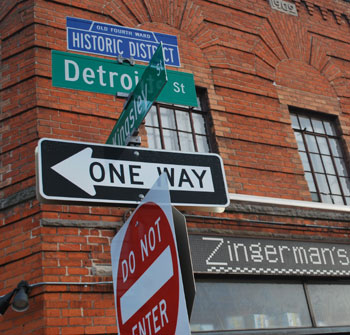
Plans to build an addition behind the brick Zingerman’s Deli building will ultimately require approval from the city’s historic district commission. (Photos by the writer.)
Zingerman’s itself is “handling a complaint” from the city’s Historic District Commission (HDC) – one that can be traced back to a June 2008 Zingerman’s request to demolish two houses, which are located in the city’s Old Fourth Ward historic district.
Now Zingerman’s is bringing back another proposal, but this time they’re not starting formally with the HDC. Instead, they’ll begin by seeking approvals from the city’s planning commission and the city council.
The site plan calls for a two-story, 9,500-square-foot structure to be added to the rear of the deli building, which will carry a price tag of around $4 million. The new building would replace the house at 322 E. Kingsley St. and extend lengthwise towards Community High School.
Zingerman’s started satisfying the formal steps for getting approval of their expansion project this week, on Monday, March 8, by holding a citizens participation meeting.
But Zingerman’s has also met informally with the HDC at two separate work sessions since the start of the year – one in January and the other on Thursday, March 11. Based on a significant change in design between those two meetings, which integrates “the orange house” into the project instead of demolishing it, Zingerman’s is trying to “make it right” for the HDC.
Still, at Thursday’s HDC work session, the Zingerman’s team stressed how great the challenges were – financial and logistical – to preserving the orange house as part of the project design. It seemed apparent that Zingerman’s was making an implicit pitch for members of the HDC to give a green light for the previously proposed project – the one minus both houses. [Full Story]
Demolition Moratorium for Two-Block Area
Ann Arbor City Council meeting (Aug. 6, 2009): Two kinds of moratoria were on council’s agenda for Thursday’s meeting – which had been rescheduled to accommodate the Aug. 4 Democratic primary elections in Wards 3 and 5. The first was a moratorium on new development in districts zoned with the classification of R4C (multi-family residential) or R2A (two-family residential). The second was a moratorium on demolition, attached to the creation of a study committee for a possible historic district in a two-block area just south of William Street on Fourth and Fifth avenues.
Council voted down the more general prohibition on new development in R4C/R2A residential districts, but approved the historic district study committee with its attached moratorium on demolition. It’s a case where the vote tally alone doesn’t tell the whole story – or even an accurate one: Counter to what one might expect, Mike Anglin (Ward 5) voted against the R4C/R2A moratorium, while Leigh Greden (Ward 3) voted for it.
A third major agenda item facing council was also related to new development: the Near North planned unit development (PUD) proposed for North Main Street just south of Summit Street, which is an affordable housing project that includes the nonprofit Avalon Housing as a partner. The council voted to move Near North on to a second reading, when a final decision will be made.
But probably the most important matter considered by council on Thursday appeared on the agenda as an “introduction” by the city’s chief financial officer, Tom Crawford, who spent around a half hour telling the city council why the city’s projected financial condition is worse now than it had been when the FY 2010 budget was adopted in the spring. Crawford’s presentation was characterized during commentary from the public later in the meeting as the “first salvo in a PR campaign” for a city income tax.
A bit of breaking news from Crawford’s report: bonds for the Fifth Avenue underground parking garage were issued on Aug. 5. [Full Story]
Historic Commission: No Approval for Demolition
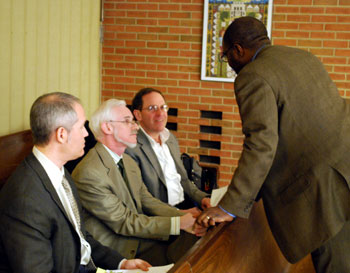
From left to right: Ron Mucha, Greg Jones, David Strosberg, Kevin McDonald (city attorney's office). Mucha and Strosberg are with Morningside LLC, while Jones, a former chair of Ann Arbor's Historic District Commission, is the architect on the parking lot.
By the conclusion of its Thursday evening meeting, Ann Arbor’s historic district commission had denied the application by Morningside LLC for permission to demolish two houses on the Old West Side.
Morningside wanted the option for demolition of the structures to give them more flexibility in the marketing of a 19,000 square foot greenhouse space adjoining the Liberty Lofts condominium project. The plan was to add additional parking spaces, if a tenant requested them.
The commission took three votes on three different motions related to the application for demolition, but was not able to pass any of them. The votes all split 3-3 among the six commissioners who attended the meeting. Given the failure to pass any of the motions, the body had fully considered the application and thus acted on it without approving it, which meant that the application failed.
What were all those motions about? [Full Story]
Demolition in Historic District?
At its Thursday meeting, Ann Arbor’s historic district commission gave approval for the demolition of a service station at Second & West Liberty streets.

The intersection of West Liberty and Second streets, looking north to south. (Image links to Microsoft's Bird's Eye View for additional detail.) The structures proposed for possible demolition are the corner service station and the two houses next door. The greenhouse space being marketed as destination retail is at the left of the frame, across the existing parking lot from the three structures proposed for demolition.
At its next meeting in March, the HDC will consider whether to give permission to proceed in demolishing two houses next door to the service station.
The permission for demolition was sought by Morningside Ann Arbor LLC, which developed the Liberty Lofts residential project in the former Eaton factory on the same block. Morningside’s reasons for seeking permission to demolish the three structures are related to another historic structure on the block: the former greenhouse space adjoining Liberty Lofts, which runs along First Street and the railroad tracks.
In order to market the former greenhouse space to retail tenants as having potential for more parking than the current 54 spaces, Morningside wants the option of expanding parking in the area where the three structures currently stand. [Full Story]




